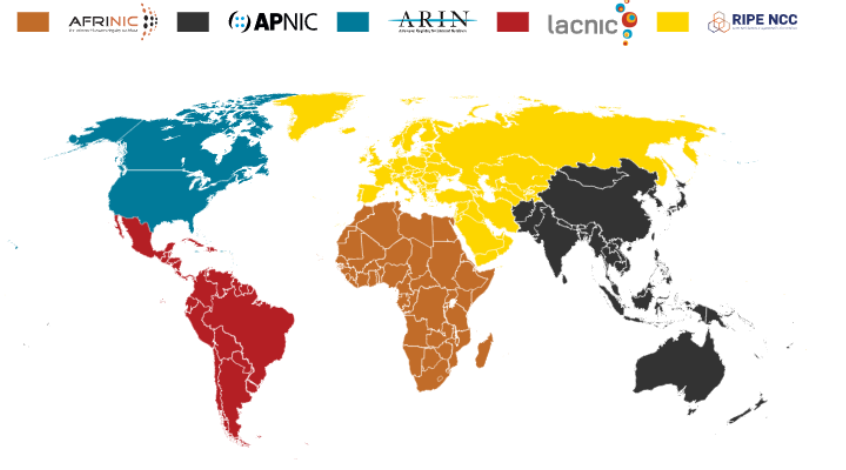Are We Running Out of Static IPv4 Addresses?
Are we running out of static IPv4 addresses? No, we’re not running out – we’ve run out. In this guide, we'll explain what has led to IPv4 address exhaustion.

Jul 19, 2023
SHARE
Are we running out of static IPv4 addresses? No, we’re not running out – we’ve already run out.
4.3 billion IPv4 addresses kept us going for a while, there. But it turns out the number of possible combinations of a 32-digit code doesn’t provide anywhere near enough individual IP addresses for everyone to get online.
IPv4 address exhaustion is a global problem. IP addresses are managed and distributed by Regional Internet Registries (RIRs) – non-profit organizations that manage and distribute internet protocol (IP) address space and autonomous system (AS) numbers (basically networked groups of IP addresses). Each RIR controls a different world region and as non-profits, they usually work in a fairly collaborative way.

There are five RIRs.
AFRINIC: Africa, regions of the Indian Ocean
APNIC: Regions of Asia and Oceania
ARIN: Canada, many Caribbean and North Atlantic islands, and the United States
LACNIC: Latin America and regions of the Caribbean
RIPE NCC: Europe, the Middle East, Central Asia
What’s the one thing they all have in common? A distinct lack of IPv4 addresses left to distribute. ARIN ran out back in 2015, followed by RIPE NCC in 2019. The three remaining RIRs are strictly rationing and distributing their remaining supply, in accordance with their community policies.
What’s the Alternative to Static IPv4 Addresses?
If the idea of bidding for these scarce digital resources doesn’t appeal, the obvious answer is to switch to IPv6 addresses.
This newer protocol is based on a 128-digit code, as opposed to the 32 digits of IPv4. This gives us more possible combinations, with 340 undecillion different IPv6 addresses available (one undecillion is equal to one trillion, trillion, trillion). It’s unlikely to run out anytime soon (if ever, according to analysts).
Due to this abundance of IPv6 addresses, they’re less expensive than IPv4 (if you’d like to find out more about the differences between IPv4 and IPv6, including rough costs, we wrote this handy guide for you).
Not Ready for IPv6?
For large enterprises, the additional cost of purchasing static IPv4 is outweighed by the logistical costs and disruption of migrating their whole organization to IPv6. This may require major overhauls of hardware and software to ensure compatibility, as well as integrating entirely new IP address management (IPAM) systems.
Your IT administrators are likely to put off this transition as long as possible, with good reason – it’s a large project without any real return on investment in the short-to-medium term.
Not that obtaining new IPv4 is a walk in the park, of course. The RIRs hold back a precious few in reserve – but if you want to access them, you’ll need to fill out a detailed justification form. There are several online brokers who can help you access these remaining IPv4s, for the right price.
Several canny carriers have kept a few IPv4 addresses in reserve. They’ll also need you to fill out an extensive justification form, before charging you the current going rate, or above, for a block of static IPv4 addresses.
Dual Stacking
Companies looking to start their IPv6 implementation without the trauma are increasingly exploring dual stacking as an interim solution.
Dual-stacking solutions allow both systems to run simultaneously. Your network benefits from the technical advantages of IPv6, while maintaining the consistency and reliability that remaining in the IPv4 ecosystem provides (for now).
This approach allows the financial costs and technical difficulties of migration to be spread over a longer period, making them more manageable and predictable.
It seems transitioning to IPv6 is an inevitable step every enterprise is going to take.
The only question is whether your organization will benefit from early adoption (as Amazon seems to expect, judging by their recent migration of their serverless and container AWS workloads) or whether the eventual tipping point of mass adoption will provide a more cost-effective and efficient opportunity.
Either way, if Static IPs are on your radar, Lightyear provides an automated telecom procurement platform, backed by experienced industry professionals, to assist and advise you through either IPv4 or IPv6 address purchases, along with any dual-stacking or migration projects you hope to undertake.
Want to learn more about how Lightyear can help you?
Let us show you the product and discuss specifics on how it might be helpful.
Not ready to buy?
Stay up to date on our product, straight to your inbox every month.
